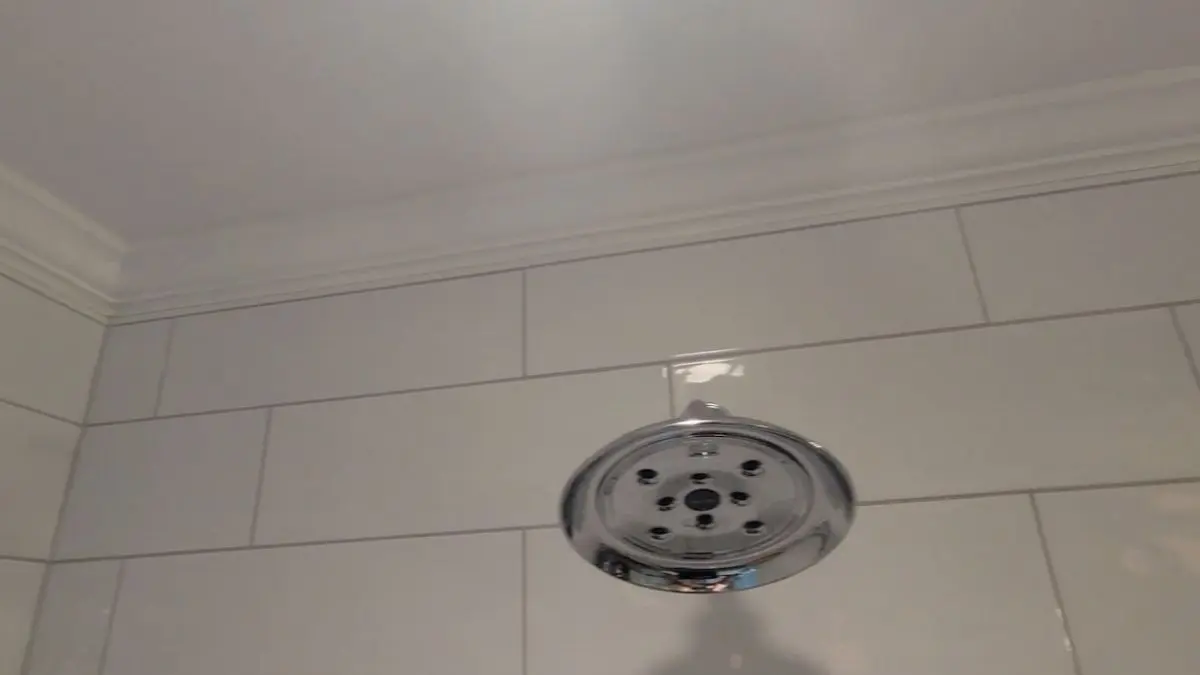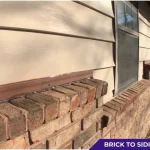Crown molding is a decorative feature that enhances the look of any bathroom. It creates a refined transition between the ceiling and walls, adding a polished touch. However, when installing crown molding in a bathroom, especially where wall tiles meet drywall, the transition can be tricky. Bathrooms often have unique design challenges, such as moisture, humidity, and different materials, that require careful attention during installation.
In this guide, we will explore how to transition crown molding from wall to tile, offering various styles and installation tips to ensure a smooth, elegant finish. Whether tiling to the ceiling or only part of the wall, learning the right techniques will make a big difference in achieving a professional look. We’ll also discuss alternatives to crown molding and highlight the differences between DIY and professional installations.
Let’s dive into the best practices for incorporating crown molding into your bathroom design.
What is Crown Molding?
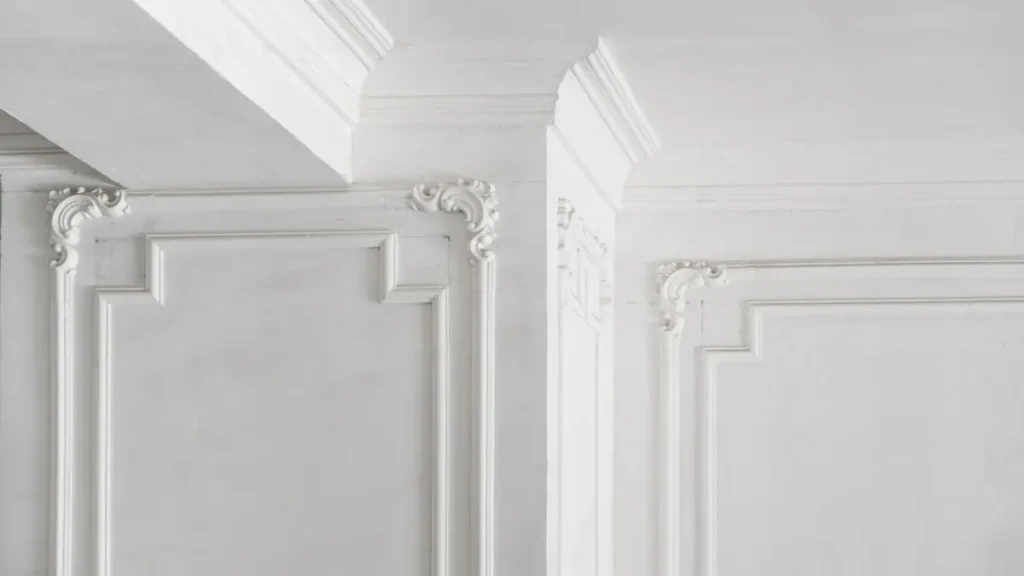
Crown molding is a decorative trim that runs along the top edges where walls meet ceilings or, in this case, where walls meet tile surfaces. Traditionally used to enhance the architectural detail of a room, crown molding adds a sophisticated touch by creating a visually smooth transition between different surfaces. In bathrooms, where walls often meet tile or other contrasting materials, crown molding serves both aesthetic and functional purposes.
Why Use Crown Molding in Bathroom Transitions?
In bathrooms, crown molding offers several benefits:
Aesthetic Appeal: It adds a finishing touch that can elevate the design of your bathroom, making it look more polished and complete. The molding can seamlessly integrate the tile with the wall, creating a unified and elegant look.
Covering Gaps: Bathrooms are often prone to gaps and imperfections where tile and wall surfaces meet. Crown molding effectively conceals these imperfections, creating a clean and professional appearance.
Transitioning Between Surfaces: Crown molding helps to smoothly transition from wall to tile, especially if the tile has a different texture or color. This makes the change less abrupt and more visually appealing.
Crown Molding When Tiling to the Ceiling
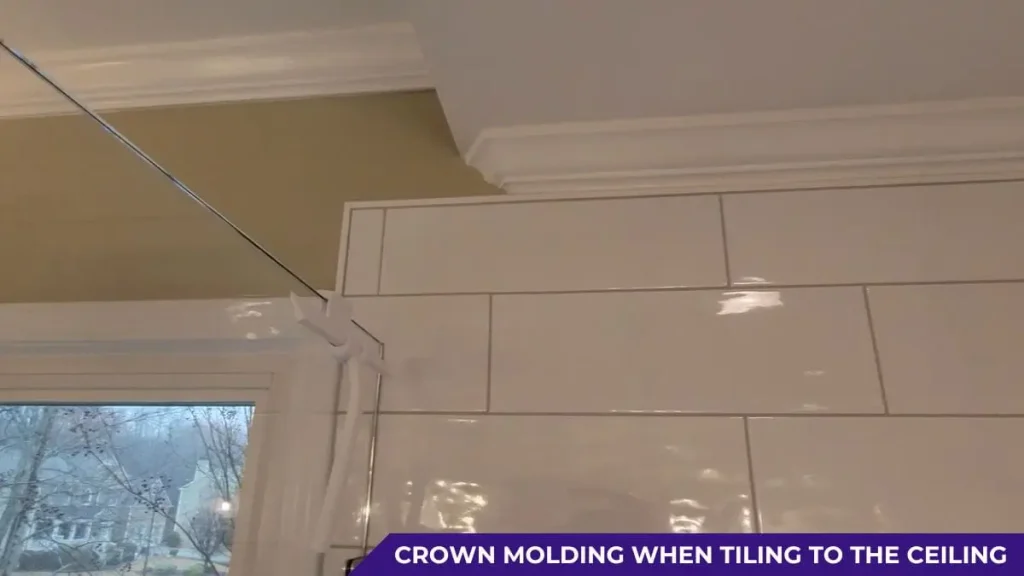
Tiling to the ceiling creates a sleek and modern look, especially in bathrooms where moisture resistance is essential. Adding crown molding to this design can enhance the elegance of the room, but it requires special consideration due to the presence of both tile and ceiling materials. Here’s how to approach crown molding when your bathroom tiles extend to the ceiling.
What Styles of Crown Molding Work Best With Ceiling Tiles?
Crown molding that complements your tile design can elevate the overall look of your bathroom. When choosing the right style, it’s important to consider both aesthetic and practical factors, such as moisture resistance and durability.
- Classic Moldings: Traditional styles, like cove or colonial crown molding, work well with tiles that have neutral or natural finishes, such as marble or ceramic. They offer a timeless look that blends well with elegant bathroom designs.
- Modern Moldings: If your bathroom features sleek tiles like porcelain or glass, minimalist crown molding styles with clean, sharp lines will provide a contemporary finish. Flat or simple crown molding designs avoid overwhelming the visual impact of the tiles.
- Moisture-Resistant Materials: For bathrooms, crown moldings made from PVC or polyurethane are ideal. These materials resist moisture and prevent warping over time, which is particularly important in areas exposed to steam and water.
How to Install Crown Molding Over Tile?

Installing crown molding over tile requires careful planning and the right tools to ensure a secure fit. The process can be more complex than standard drywall installations, as tile surfaces are harder to nail into. Here’s a step-by-step guide:
- Measure and Cut the Molding: Begin by measuring the wall and ceiling length to ensure accurate cuts. Use a miter saw to cut the crown molding at the appropriate angles, ensuring the corners fit snugly.
- Use Adhesive Instead of Nails: Since nails won’t penetrate tile easily, it’s best to use a strong construction adhesive. Apply the adhesive along the back of the molding where it will meet both the ceiling and the tiled wall.
- Secure the Molding: Once applied, press the molding firmly against the tile and ceiling. Use temporary bracing or painter’s tape to hold the molding in place while the adhesive dries.
- Seal the Gaps: After the molding is set, fill any gaps between the tile and molding with a waterproof caulk to ensure a seamless and water-resistant finish.
What Are the Challenges of Crown Molding with Ceiling Tiles?
Working with crown molding and ceiling tiles comes with unique challenges that can complicate the installation process. Here are the most common issues and how to handle them:
- Tile Thickness Variations: Tiles are often thicker than drywall, which can create an uneven surface for molding. To address this, opt for thicker crown molding to bridge the gap or use spacers behind the molding to create an even surface.
- Mitered Corners and Tile Edges: Aligning mitered corners with tile edges can be tricky, especially if the tiles are uneven. To solve this, make precise cuts and consider using corner blocks to simplify the installation process.
- Moisture and Expansion: Bathrooms are prone to humidity, which can cause expansion or warping of certain materials. Using moisture-resistant crown molding materials, like PVC or polyurethane, can help avoid long-term damage.
How Does Crown Molding Impact Bathroom Design Aesthetics?
Crown molding adds a touch of luxury to any bathroom design, especially when paired with tile that extends to the ceiling. The molding acts as a transition between the two materials, softening the look and creating a balanced, cohesive appearance. Here’s how it impacts the overall aesthetics:
- Increased Height Perception: Crown molding draws the eye upward, making the room feel taller and more spacious, which is especially beneficial in smaller bathrooms.
- Elegance and Sophistication: The addition of crown molding introduces an element of sophistication, elevating the bathroom’s design by providing a refined finish.
- Enhanced Texture and Contrast: When combining tile with crown molding, the contrast between the smooth tile and the detailed molding creates visual interest and depth in the room.
Transitioning Crown Molding Between Tile and Drywall
Transitioning crown molding between tile and drywall presents a unique design challenge in bathroom remodels. These materials have different textures and thicknesses, so the installation requires special techniques to ensure a seamless connection. Done correctly, this transition can enhance the overall aesthetic of the room, creating a smooth, polished look where the two surfaces meet.
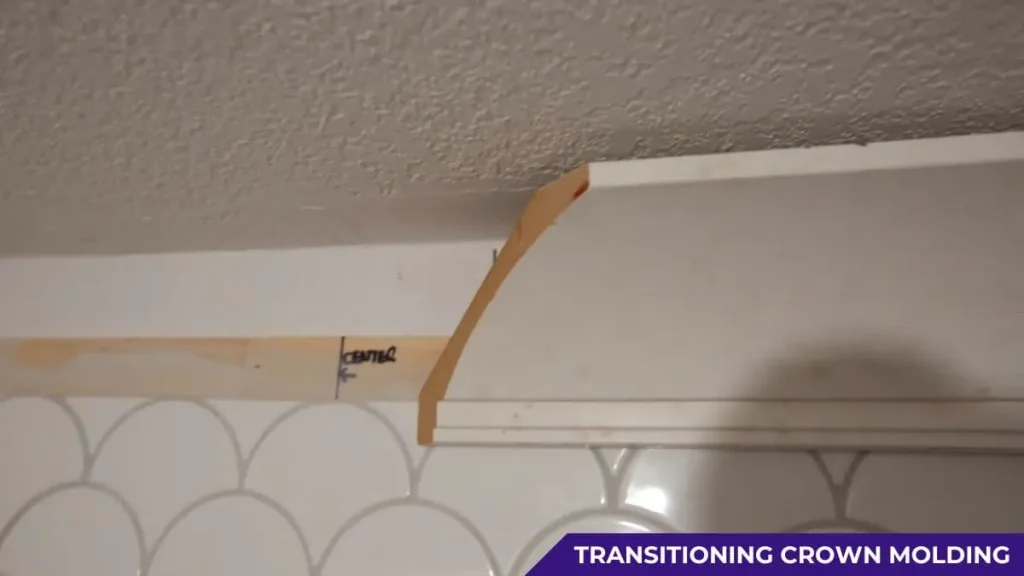
How Can Crown Molding Create a Smooth Transition Between Tile and Drywall?
Crown molding serves as an elegant bridge between tile and drywall, creating a cohesive design. Bathrooms often have tiled walls in wet areas like showers or around tubs, while the rest of the space may feature painted drywall. Without a proper transition, the shift between these materials can look disjointed.
Crown molding, when used strategically, helps merge these two surfaces. For instance, the molding can be installed to run continuously around the room, connecting tiled sections with drywall areas, and maintaining uniformity across the space. It ensures that there is no visual break, blending the two materials harmoniously. By using the right molding style and material, you can achieve a consistent flow throughout the bathroom.
What Are the Key Installation Tips for a Tile-Drywall Transition?
Installing crown molding between tile and drywall involves precise measurement and alignment to ensure a smooth transition. Since tiles are typically thicker than drywall, the molding must account for these variations. One solution is to use thicker molding that accommodates the height difference, ensuring that the molding sits evenly across both surfaces.
When installing, measure carefully to avoid gaps where the tile meets the drywall. Apply adhesive generously along the back of the molding, particularly in areas where the molding will attach to the tile, as this surface is more challenging to bond. In contrast, for the drywall section, you can use both adhesive and finishing nails to secure the molding.
Another important tip is to caulk the edges where the molding meets both the tile and drywall. Caulking not only fills small gaps but also creates a waterproof barrier, which is critical in bathrooms. This ensures a smooth, seamless transition between the two surfaces while protecting the molding from moisture.
What Are Common Challenges When Transitioning Crown Molding?
The process of transitioning crown molding between tile and drywall can present several challenges, primarily due to differences in thickness and surface textures. One of the most common issues is achieving a level surface across the transition area. Because tile is often thicker, the molding may sit unevenly, creating gaps or an unsightly finish. To overcome this, some installers use shims or spacers behind the drywall portion of the molding to create an even plane.
Another challenge is working with corners, especially where the tile ends and the drywall begins. The shift from one material to another can make it difficult to align mitered corners. For this reason, it is important to measure precisely and cut molding pieces carefully to fit the angle where tile and drywall meet.
Moisture is another concern in bathrooms. Crown molding materials like wood are prone to warping if not installed correctly. To prevent long-term damage, it’s crucial to choose water-resistant materials such as PVC or polyurethane, which are less affected by humidity.
Can Crown Molding Affect the Bathroom’s Design Aesthetics?
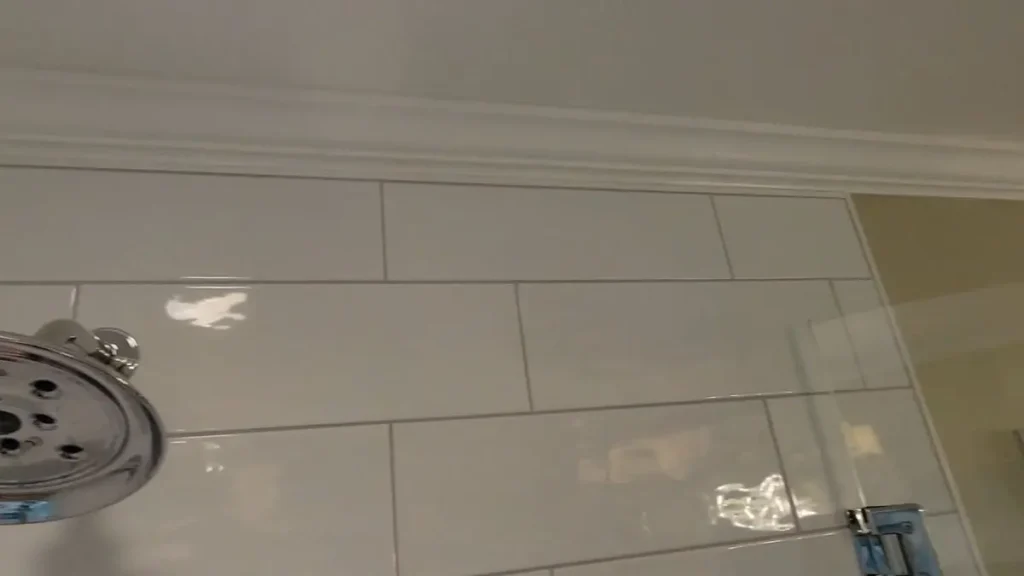
Crown molding significantly influences the aesthetic flow of a bathroom, particularly where tile and drywall meet. Without a transition element like crown molding, the shift between these materials can feel abrupt and unfinished. By introducing molding, you create a smooth visual connection that enhances the overall look of the room.
In terms of design, crown molding helps balance the texture of the tile with the flatness of drywall. This transition can soften the shift between the two surfaces, adding a level of refinement to the space. Additionally, the molding provides a frame that ties together different sections of the room, making it feel more cohesive.
Should You Hire a Professional or Try a DIY Installation?
When it comes to transitioning crown molding between tile and drywall, deciding between a professional installation or a DIY project depends on the level of experience and the complexity of the bathroom’s layout. Installing crown molding around tile requires precise measurements, cuts, and the right tools. For those with little experience in molding installation, the job can quickly become overwhelming, especially when dealing with uneven surfaces or mitered corners.
A professional installer brings expertise that ensures a clean, seamless transition. They understand the nuances of working with different materials, and they have the equipment to cut and install molding accurately. Professionals are also more familiar with moisture-resistant materials and know how to prevent issues like warping or gaps.
On the other hand, experienced DIYers who are comfortable with woodworking tools and techniques can save money by handling the project themselves. However, it’s important to follow the proper steps, use high-quality materials, and take precise measurements to avoid common pitfalls. DIYers should also be prepared to invest time and patience into ensuring the molding aligns perfectly between tile and drywall.
Ultimately, the choice comes down to skill level and confidence in handling detailed work. A professional installation guarantees a polished look, while a DIY project offers the satisfaction of completing the job personally, as long as careful attention is given to the details.
Alternative Solutions: Baseboard Transitions and Other Design Ideas
When it comes to transitioning between tile and drywall in a bathroom, crown molding isn’t the only solution. There are other creative options, such as baseboard transitions and various design ideas that can enhance the space while ensuring a seamless flow between materials. These alternatives offer practical and stylish choices for homeowners looking for versatility or who may want to avoid the complexity of crown molding installation.
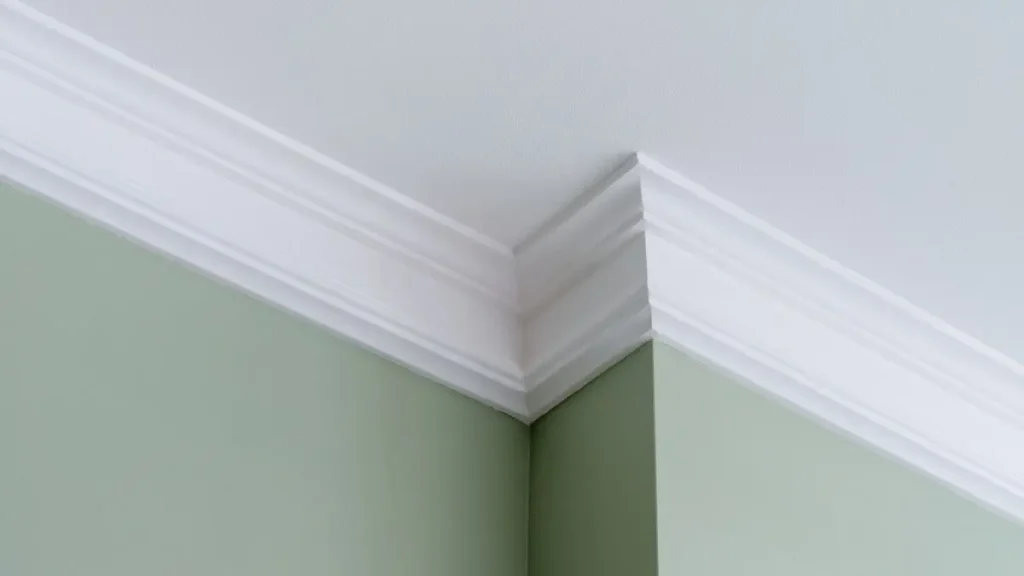
Baseboard Transitions: A Practical Alternative
Baseboard transitions offer a more straightforward alternative to crown molding, especially in bathrooms where the design calls for a clean, minimalist look. Instead of placing crown molding at the top of the walls where they meet the ceiling, baseboards can be used to connect the bottom of the walls to the floor or tiled surfaces. This creates a natural boundary between materials while maintaining the room’s cohesion.
The installation of baseboards between tile and drywall tends to be simpler because baseboards are typically used to cover the bottom edge of walls. They can be applied directly over both tile and drywall without the need for precision cuts around the top edges of walls. In addition, they provide a uniform transition that eliminates any awkward height differences between materials, as baseboards can often be custom cut to match the thickness of each surface.
Baseboards also offer versatility in style. You can choose from traditional wood or opt for more moisture-resistant materials like vinyl or PVC. These materials are well-suited for bathrooms where water exposure is a concern, and they can be painted or left with a natural finish depending on the aesthetic you’re aiming for.
Tile Trim for Seamless Finishes
Another option that works well in bathrooms is tile trim. Tile trim pieces are designed to create a smooth edge where tiled areas meet other materials, like drywall, or at the corners of tiled surfaces. Tile trim serves both functional and aesthetic purposes by protecting the edges of tiles from chipping while adding a finished look to the room.
Tile trim comes in various materials, such as aluminum, stainless steel, and PVC, and can be found in different colors to match or contrast with your bathroom tiles. It is typically installed alongside the tile during the tiling process, ensuring a clean and professional finish. This method is particularly useful for smaller bathrooms where crown molding or baseboards may feel too bulky.
For a minimalist and modern aesthetic, tile trim can create a sleek transition between the tiled area of the shower or backsplash and adjacent drywall. It eliminates the need for additional molding and complements contemporary bathroom designs by maintaining clean, uninterrupted lines.
Read Also: How to Remodel a Shower Stall With Tile
Wainscoting for Added Texture and Visual Interest
Wainscoting is a decorative wall treatment that adds texture and visual interest to bathroom walls while also serving as an alternative solution for transitioning between materials. In a bathroom, wainscoting is typically installed on the lower half of the walls, below tile or drywall, and can be paired with baseboards or trim to complete the look.
For a smooth transition between tile and drywall, wainscoting provides a classic, elegant solution. The vertical panels of wainscoting break up the wall space, drawing attention away from the material change and adding a sophisticated design element. This approach works especially well in bathrooms with a traditional or cottage-style design, but wainscoting can be customized to fit modern aesthetics as well.
Wainscoting comes in various materials, including wood, beadboard, and moisture-resistant alternatives like PVC, which are better suited for high-humidity environments like bathrooms. Installing wainscoting requires careful alignment, particularly if it is being used as part of a tile-to-drywall transition. The addition of crown or base molding at the top and bottom of the wainscoting completes the polished look.
Chair Rails: A Decorative Divider
Chair rails, traditionally used in dining rooms to prevent chairs from damaging walls, can also serve as a decorative divider in bathrooms. Similar to wainscoting, chair rails create a horizontal break in the wall, making them an excellent option for dividing tile and drywall sections. Installed at the junction between these materials, a chair rail provides a smooth, finished boundary without the bulk of crown molding.
In bathrooms, chair rails can be especially effective in small or narrow spaces. They help define different sections of the wall while adding a subtle decorative touch. A chair rail placed between a tiled backsplash or shower wall and the remaining drywall helps create a cohesive look, especially when painted in a color that contrasts or complements the tile.
Chair rails are generally thinner than crown molding, so they are less intrusive but still offer the same functionality of bridging the gap between materials. They can be made from wood, PVC, or other moisture-resistant materials, making them durable and long-lasting in a bathroom environment.
Integrated Tile Borders for a Clean Look
For those seeking a minimalist design, integrated tile borders are another effective way to transition between tile and drywall. This method involves extending the tile slightly above the main tiled area to create a subtle border. This technique is especially popular in modern bathroom designs where clean, sleek lines are a priority.
Integrated tile borders remove the need for additional materials like crown molding, baseboards, or chair rails. Instead, the tile itself becomes the transition point. This solution works well in showers or around bathtubs, where the border provides a neat finish to the tiled surface without requiring additional trim. It’s also an excellent option for small bathrooms where maximizing space and minimizing clutter is essential.
When installing integrated tile borders, careful planning is necessary to ensure that the height of the border aligns with the drywall and other elements in the room. The tile chosen for the border should either match the main tile or provide a subtle contrast, depending on the overall design vision for the space.
Considerations for Choosing the Best Transition Solution
When deciding on the best alternative transition between tile and drywall, several factors should be considered, including the size of the bathroom, the overall design aesthetic, and the level of moisture in the space. Crown molding may be the go-to choice for some, but for others, baseboards, tile trim, wainscoting, or chair rails might be more appropriate.
Smaller bathrooms or those with a minimalist design benefit from simpler transitions like tile trim or integrated tile borders. These options help maintain a streamlined look without overwhelming the space with additional molding or trim. For larger bathrooms or those with a more traditional aesthetic, crown molding or wainscoting can add the desired level of sophistication and texture.
The moisture level in the bathroom is another key consideration. Areas like showers or near bathtubs require water-resistant materials to avoid long-term damage. PVC or vinyl baseboards, chair rails, and trim are excellent choices in these situations, as they provide durability while maintaining their appearance over time.
Ultimately, the best transition solution depends on the overall design goals, the bathroom’s layout, and personal preference. Whether you opt for crown molding, baseboard transitions, or one of the other design ideas discussed, the key is to ensure that the transition is seamless and aesthetically pleasing.
Practical Tips for Installation and Design Aesthetics
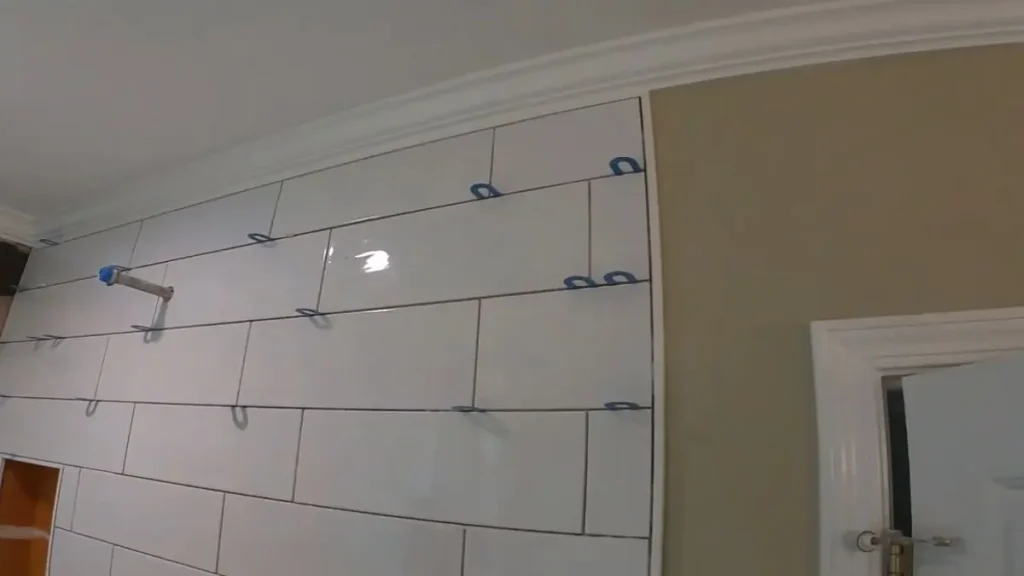
Installing crown molding or any other transition between tile and drywall requires precision, creativity, and an eye for detail. Whether you’re working with traditional crown molding or exploring alternative design solutions like baseboards or tile trim, understanding the nuances of installation and design can make all the difference in the final look.
To achieve a flawless, professional finish, consider the following installation techniques and design aesthetics tailored to various scenarios.
Proper Measurements and Precision Cuts
One of the most critical aspects of installing crown molding or any other transitional element is ensuring accurate measurements and precise cuts. Poor measurements can lead to gaps, misalignments, or uneven finishes, all of which will detract from the polished look you want to achieve.
When preparing to install crown molding, it’s essential to measure the length of each wall where the molding will be placed. This includes taking into account any corners, which require miter cuts—angled cuts that allow two pieces of molding to meet seamlessly. Miter cuts should be done carefully using a miter saw, and the angle must be accurate to prevent gaps at the corners. For inside corners, coping cuts are often used to ensure a snug fit.
For other transitional elements like baseboards or tile trim, the same attention to detail is required. Baseboards must align perfectly with both the tile and the drywall to avoid visible seams, while tile trim should be installed with enough precision that it provides a smooth, even border around the tiled area. Ensuring clean, straight cuts not only improves the visual appeal but also reduces the chances of future damage or warping.
Aligning Moldings with Bathroom Fixtures and Features
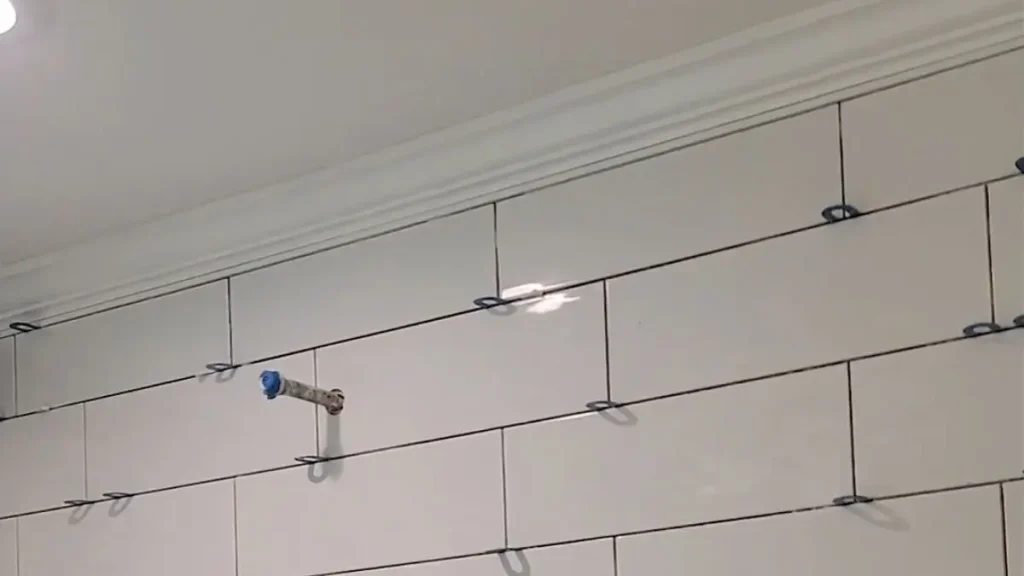
When installing crown molding or any alternative trim, it’s important to consider the placement of bathroom fixtures, such as mirrors, vanities, and lighting. Aligning the moldings with these fixtures ensures a cohesive and well-balanced design. For instance, if the crown molding runs above a tiled shower, it should extend evenly across the top of the shower enclosure and wrap around any recessed shelving or niches.
Paying close attention to the vertical alignment of baseboards, chair rails, or tile trim is equally important. These elements should not disrupt the visual flow of the room. For example, baseboards should run continuously from the tiled floor to the adjacent drywall without any breaks, maintaining a consistent height. Similarly, tile trim should frame bathroom features, such as a backsplash or mirror, in a way that complements the overall design rather than drawing attention to the transition.
When crown molding is used near light fixtures, it’s important to consider how the molding’s shadow lines will interact with the lighting. Some molding designs cast more shadows than others, which can add depth and interest to the ceiling area but could also make a small bathroom feel more confined if not carefully placed.
Color Matching and Contrast for Visual Cohesion
Choosing the right color for your crown molding or transition elements can have a significant impact on the overall look of the bathroom. For crown molding, you have the option to paint it the same color as the ceiling to create a seamless flow or choose a contrasting color to highlight the molding as a decorative feature.
If the goal is to blend the crown molding into the room without drawing too much attention, painting it the same color as the walls or ceiling will create a unified and subtle effect. This is especially useful in small bathrooms where too many contrasting elements can make the space feel busy or cluttered. On the other hand, choosing a bold color for the crown molding can create a striking visual accent, especially if the walls and ceiling are painted in neutral tones.
Baseboards and chair rails should also be color-coordinated with the rest of the room to maintain balance. For example, if you’ve chosen a darker tile for the floor, opting for a lighter baseboard will create contrast, making the baseboard stand out without overwhelming the space. Alternatively, you can paint the baseboard to match the tile color for a more blended and continuous look.
When using tile trim, it’s essential to choose a material and finish that complements the tiles. For example, if your bathroom features glossy white tiles, a matching white PVC trim can create a sleek, modern aesthetic. If you’re working with natural stone tiles, opting for a brushed metal trim can add an industrial or contemporary touch that enhances the natural texture of the tiles.
Incorporating Decorative Elements for a Custom Look
Decorative elements like rosettes, plinth blocks, and cornice corners can add a custom touch to your crown molding and trim installations. These elements provide visual interest and can enhance the overall design aesthetic of your bathroom, giving it a more tailored and sophisticated appearance.
Rosettes are decorative square or circular blocks placed at the corners of molding runs, eliminating the need for precise miter cuts. This not only simplifies the installation process but also adds a decorative flourish to the space. Rosettes work well in bathrooms with a more traditional or ornate design, where intricate detailing is appreciated. Similarly, plinth blocks can be used at the base of door frames or where baseboards meet vertical molding elements, creating a more substantial and elegant transition.
For crown molding, you can also opt for more intricate profiles, such as dentil or egg-and-dart designs, which add texture and dimension to the molding. These decorative profiles work best in bathrooms with high ceilings or more luxurious, classical aesthetics. If your bathroom features simple, modern lines, a more streamlined molding profile may be preferable to maintain a clean, minimalist look.
Incorporating these decorative elements requires careful planning to ensure they complement, rather than compete with, the other design features in the bathroom. It’s important to strike a balance between enhancing the space with custom details and maintaining visual cohesion.
Ensuring Moisture Resistance and Durability
Bathrooms are high-humidity environments, so it’s critical to choose materials that can withstand moisture and prevent damage over time. When installing crown molding or any other transition elements, it’s important to select materials that are water-resistant or treat the materials to protect them from moisture.
For crown molding, PVC or vinyl is an excellent choice in bathrooms, as these materials are impervious to moisture and will not warp or rot over time. If you prefer the look of wood crown molding, be sure to apply a water-resistant primer and paint to seal the wood and protect it from humidity.
Tile trim made from aluminum or stainless steel is highly resistant to moisture, making it a great option for wet areas like showers. For baseboards, choose moisture-resistant materials like PVC or vinyl, or, if using wood, ensure it is properly sealed. These materials can stand up to water splashes and humidity without deteriorating, ensuring that your transition elements remain durable and attractive for years to come.
Additionally, proper installation techniques are essential for maintaining moisture resistance. For instance, when installing baseboards, be sure to caulk the seams between the baseboard and the wall to prevent moisture from seeping behind the trim. This will also provide a cleaner, more polished finish.
Conclusion
Choosing the right crown molding and transition elements for your bathroom tile project is essential for achieving a polished, cohesive look. Whether you’re tiling to the ceiling or transitioning between tile and drywall, crown molding provides an elegant finish that ties the room together. By carefully considering your material choices, alignment with fixtures, color coordination, and decorative details, you can enhance the design of your bathroom while ensuring durability in a moisture-rich environment.
Alternative solutions like baseboards or tile trim also offer stylish and functional ways to transition between materials, allowing for customization based on the style and layout of your bathroom. With proper planning, precise installation techniques, and attention to scale and proportion, these finishing touches can elevate the aesthetic appeal of your space.
Whether you’re tackling the project yourself or hiring a professional, understanding these elements will help you make informed decisions that lead to a beautiful, long-lasting result. With the right approach, your bathroom will have the perfect balance of function and design, making it a place of comfort and style for years to come.

